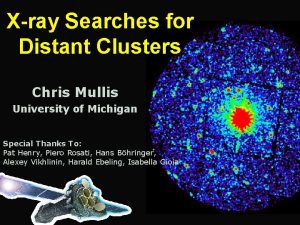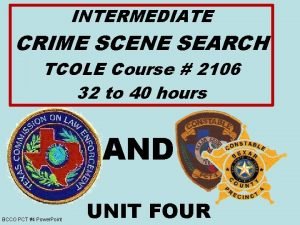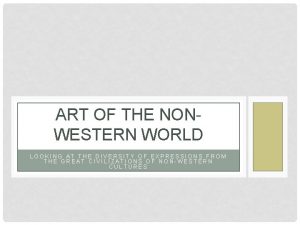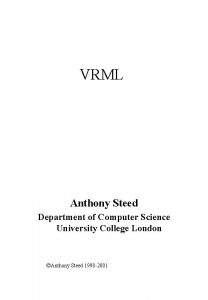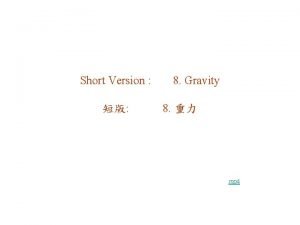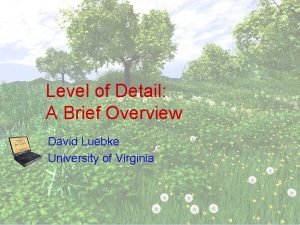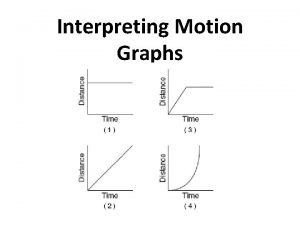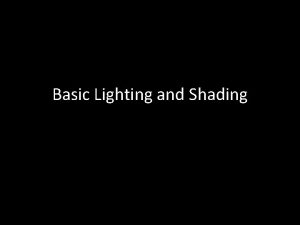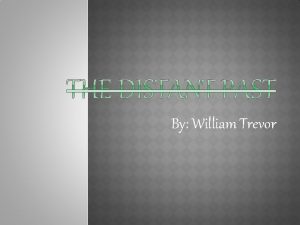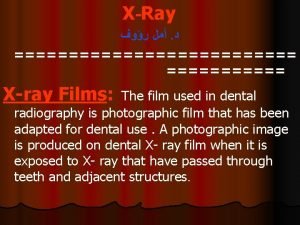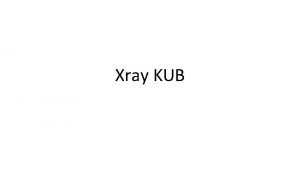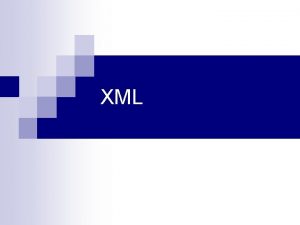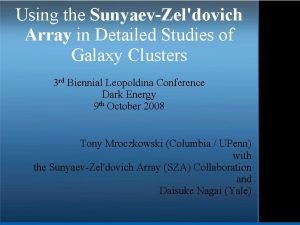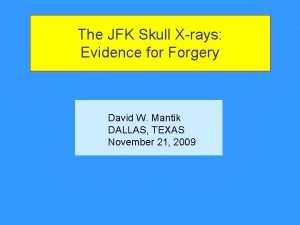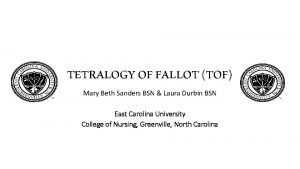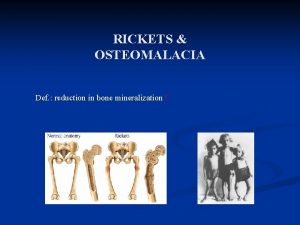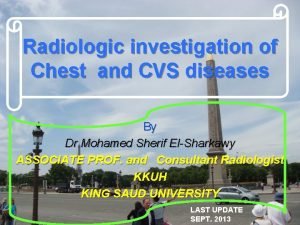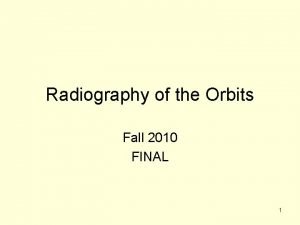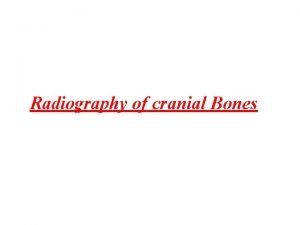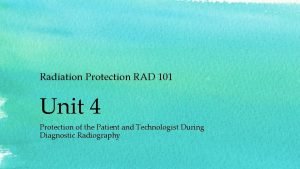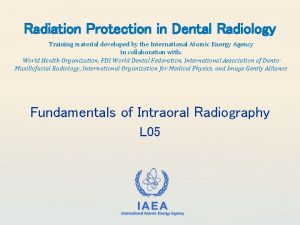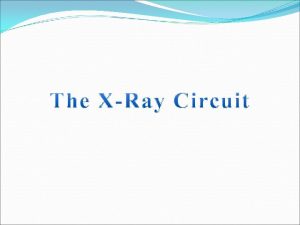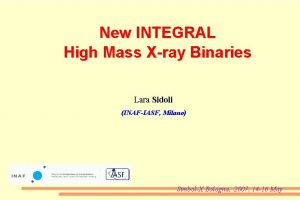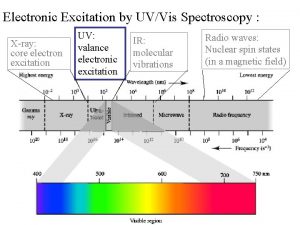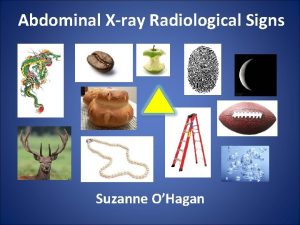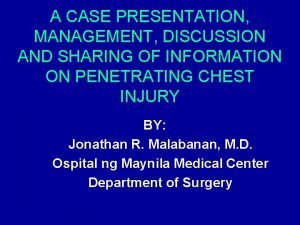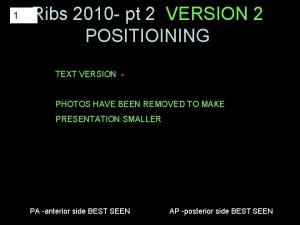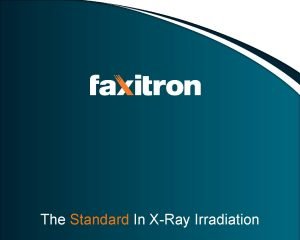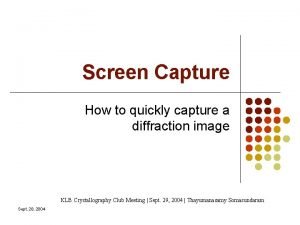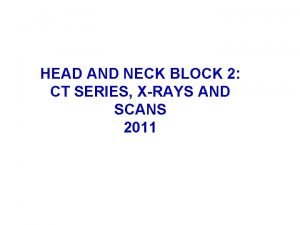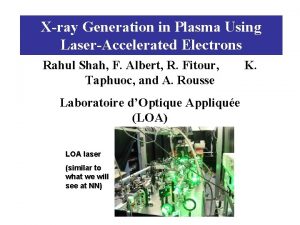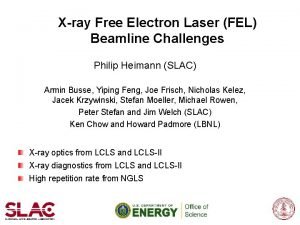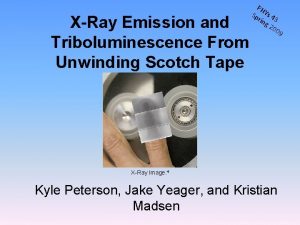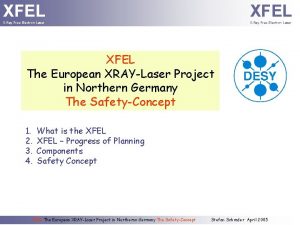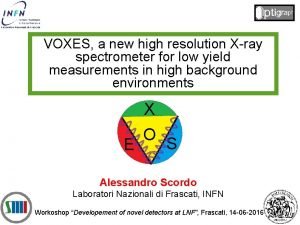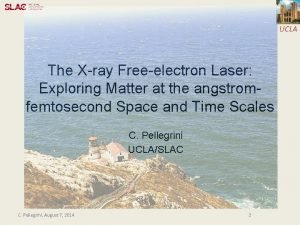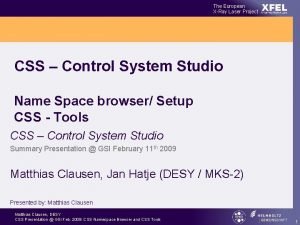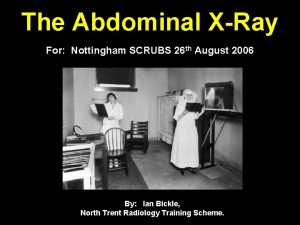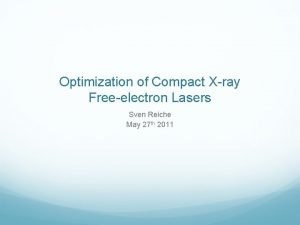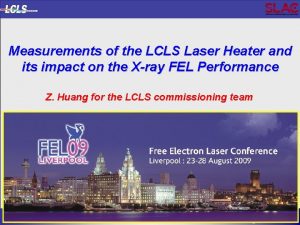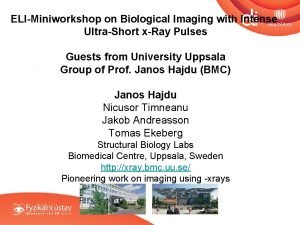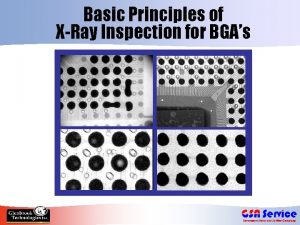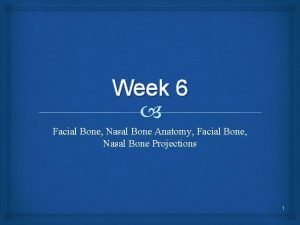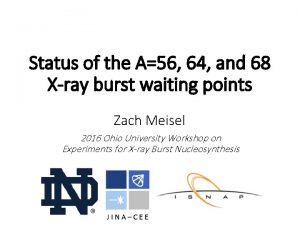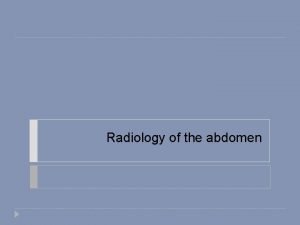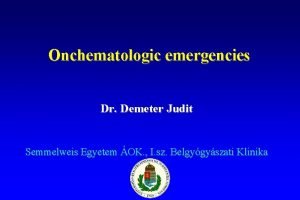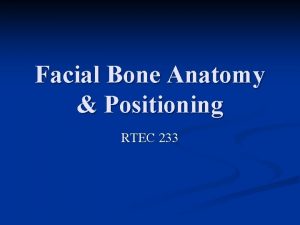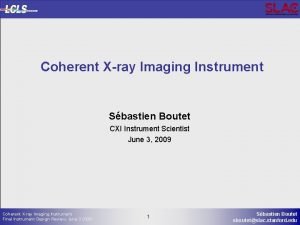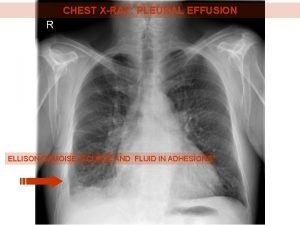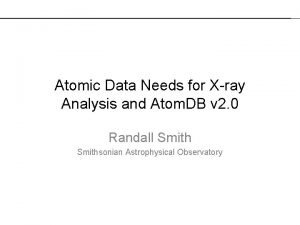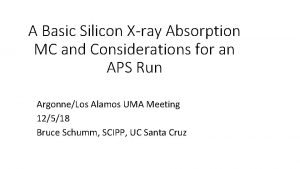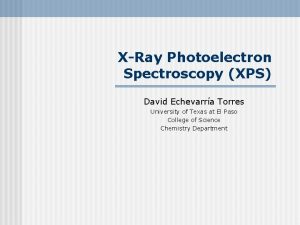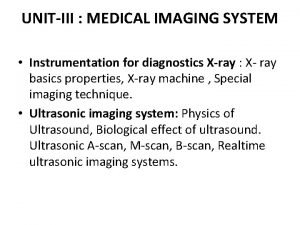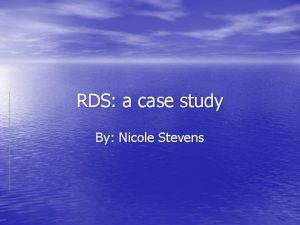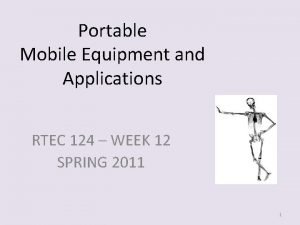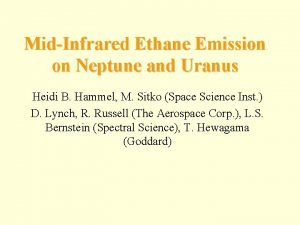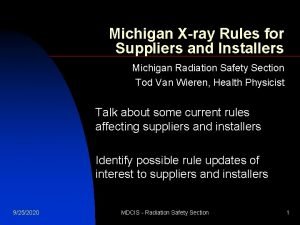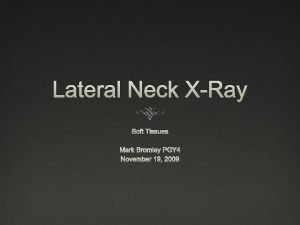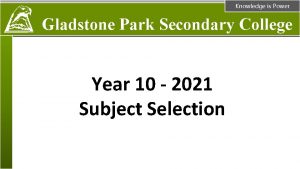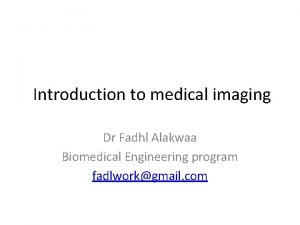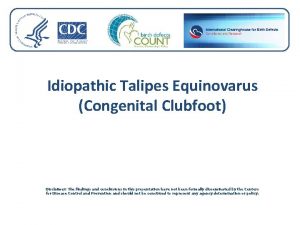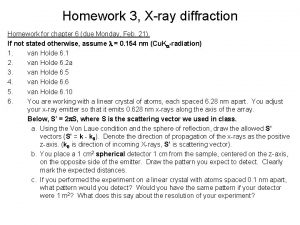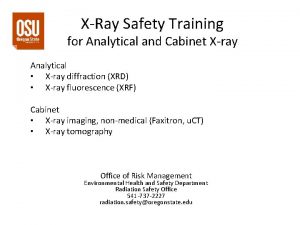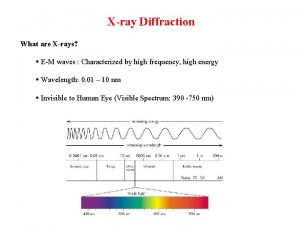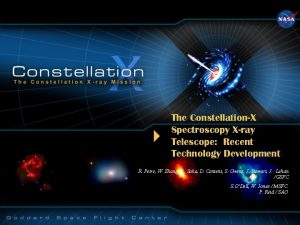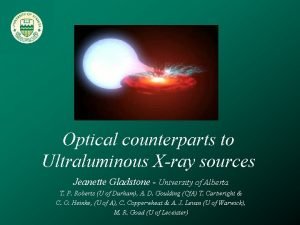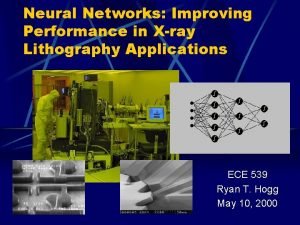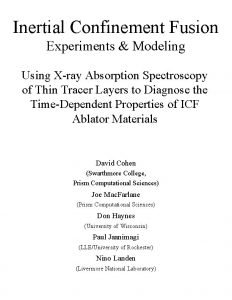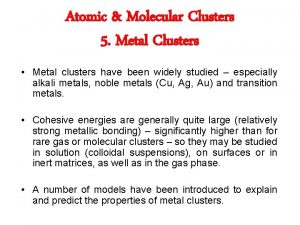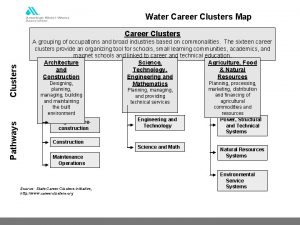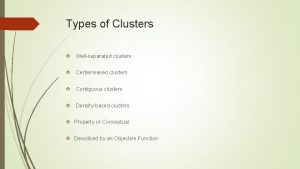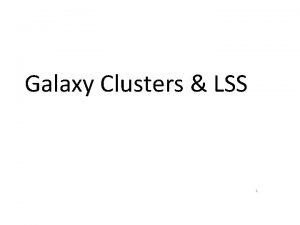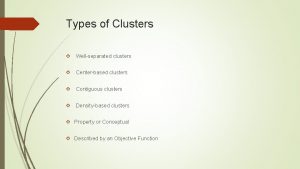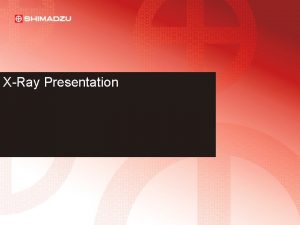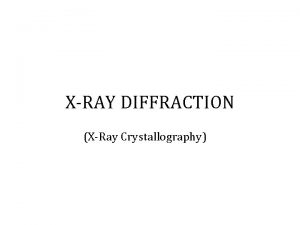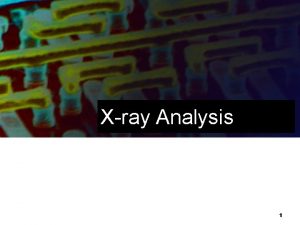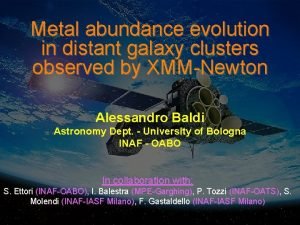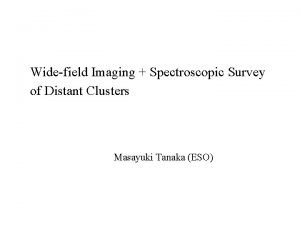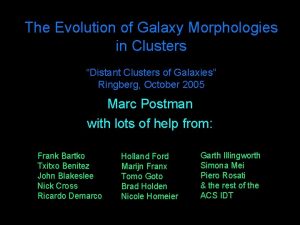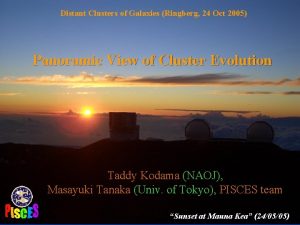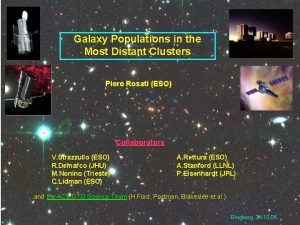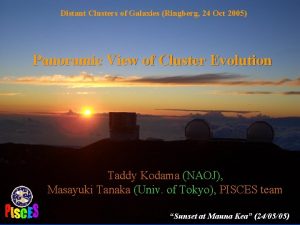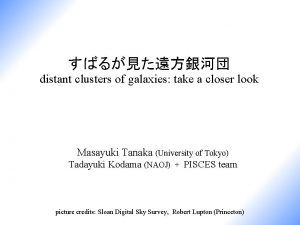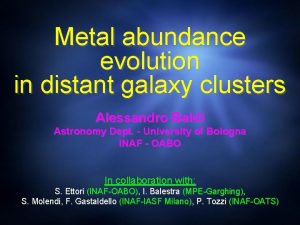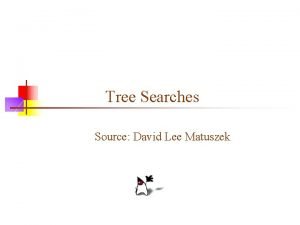Xray Searches for Distant Clusters Chris Mullis University
































































































- Slides: 96

X-ray Searches for Distant Clusters Chris Mullis University of Michigan Special Thanks To: Pat Henry, Piero Rosati, Hans Böhringer, Alexey Vikhlinin, Harald Ebeling, Isabella Gioia

Overview u Motivations u X-ray Selection & Methodology u Brief History u Current Surveys u Future Prospects

A Few Caveats… u Just highlighting examples (NOT COMPLETE REVIEW) u Recognize important work at low/intermediate redshifts u Mostly focused on z>0. 5 results

Motivations for the Study of High-Redshift Galaxy Clusters 1) Key Tracers of Large-Scale Structure Cosmological Probes

The evolution of cluster space density reflects underlying cosmology & physics Borgani & Guzzo 2001, Nature, 409, 39

Requirements for Cosmology 1) 2) 3) 4) Sensitivity over a long redshift baseline Observational proxy for cluster mass Accurate selection function High completeness / low contamination

F(Lx): Constraints on σ8 -Ωm from RDCS Clusters Borgani et al. 2001, Rosati, Borgani & Norman 2002

F(Tx): Constraints from Evolution of EMSS XTF z~0. 05 z~0. 42 Henry 1997, 2000, 2004 also Donahue & Voit 1999

F(Mb): Baryon MF of 160 SD Clusters at z~0. 5 Ωm=0. 27 z~0. 05 z~0. 55 Vikhlinin et al. 2003

Motivations for the Study of High-Redshift Galaxy Clusters 2) Laboratories for Cosmic Evolution § Formation & evolution of galaxies in high-density environments § Feedback and Chemical Yield of SNe § Thermal & chemical evolution of ICM

Galaxy Formation & Evolution Poggianti et al. 2004

Massive, High-z Clusters = Testbeds Hierarchical vs. Monolithic MS 1054 -03 z=0. 83 High-z X-ray-Selected Cluster van Dokkum et al. 2000

ICM Metal Enrichment History Star Formation History of Cluster Galaxy Population Non-Evolving(? ) Gas Iron Abundance out to z=1. 2 Tozzi et al. 2003 See also Ettori 2005

High redshift = leverage precision of cosmological parameters efficacy of evolution studies

RXJ 1716+6709 z=0. 81 ROSAT NEP Survey Henry et al. 1997, Gioia et al. 1999, Mullis 2001

Chandra ACIS-I, 51 ks, 3 -10 kev RXJ 1716+6709 z=0. 81 ROSAT NEP Survey Henry et al. 1997, Gioia et al. 1999, Mullis 2001

Advantages of X-ray Selection n Basic X-ray observable (Lx) directly related to a fundamental physical property (M)

X-ray Luminosity versus Mass Reiprich & Böhringer 2002; see also Popesso et al. 2005

Advantages of X-ray Selection n Essentially free of projection effects - low X-ray background - L x n e 2 clusters appear more sharply in X-ray than optical light complete samples

DSS galaxy group HCG 94 galaxy cluster Abell 2572

DSS + ROSAT PSPC galaxy cluster z=0. 155 galaxy cluster z=0. 042 galaxy group z=0. 039 Ebeling et al. 1995

Advantages of X-ray Selection n Basic X-ray observable (Lx) physically motivated and directly related to a fundamental physical property (M) n Essentially free of projection effects complete samples n Well-defined selection function, (fx) volume normalized diagnostics (e. g. XLF, XTF MF)

Building X-ray Samples Number Density - Flux Relation Cluster log. N-log. S: Rosati, Borgani & Norman 2002 (ARAA)

Local Cluster XLF REFLEX Böhringer et al. 2002 See aso Ebeling et al. 1997; De Grandi et al. 1999

Predicted Redshift Distribution of Clusters foreground XLF no evolution XLF AB evolution Rosati et al. 02 Mullis et al. 04 Sky Coverage

Contiguous Regions: All-Sky or Raster ROSAT image of the NEP Henry et al. 2001 Voges et al. 2001 Gioia et al 2001 Mullis 2001

Serendipitous Survey Cluster z=0. 243 160 SD #210 Cluster z=0. 242 160 SD #208 QSO

Ground-Based Follow-up u Initial Goals: – Confirm presence of galaxy overdensity – Redshift Measurement u Classical approach …one cluster at a time u Wholesale multi-λ coverage …photometric redshifts

Optimizing for Very High-Z u u u Optical Follow-up is the Challenge Leverage Existing Data Utility of color information Cluster ellipticals with old stellar pops (e. g. , Dressler et al. 1997, Postman et al. 1998) Red-Sequence + Bracketing the 4000 A Break (e. g. Gladders & Yee 2000, Kodama & Arimoto 1997) Spectroscopy is expensive – major problem at z>1. 45 (or z>1. 63 using OII) – B 2640 A, Mg. II 2800 A, Mg. I 2852 A (e. g, . Cimatti et al. 2004) u NIR photometry enables zphot & science

Brief History Einstein EMSS 1980 s ROSAT Surveys 1990 s See Rosati, Borgani & Norman 2002 for thorough review

Key Characteristics of X-ray Sats Mission Sensitivity (approx) FWHM FOV Einstein* 1 x 60” 75’ * First with imaging optics

First X-ray Detection of Distant Clusters u Einstein Observatory (Giaconi et al. 1979) u e. g. , Henry et al. 1979 u Einstein obs. of optically-selected clusters (mostly Abell z~0. 2)

What’s Distant? EMSS Gioia et al. 1990 ab, Stocke et al. 1991 Henry et al. 1992 u 93 X-ray-selected clusters (z =0. 58) u


Einstein EMSS Evolution of the Cluster XLF z = 0. 17 Low-redshift XLF <z>=0. 17 z = 0. 33 Nov 1978 - Apr 1981 High-redshift XLF <z>=0. 33 Gioia et al. 1990 Henry et al. 1992

EMSS Clusters u Cluster Evolution -> Cosmology (Ωm) – e. g. , Oukbir & Blanchard 1996, Bahcall & Cen 1997, Eke et al. 1998, Henry 2004 u CNOC Cluster Survey e. g. , Carlberg, Yee, Ellingson 1996, Balogh et al. – Cluster Masses & Cosmology – Galaxy Evolution in Clusters & Field u Distant Clusters – MS 1054 -0321 z=0. 83 most distant EMSS cluster u e. g. , Luppino & Kaiser 1997 (WL) Donahue et al. 1998 (X-ray) u – MS 1137. 5=6025 z=0. 78 u e. g. , Donahue et al. 1999 MS 1054 -0321 z=0. 83 HST / van Dokkum & Franx

X-ray Cluster Universe Surveyed by Einstein zmax ~ 0. 8

Key Characteristics of X-ray Sats Mission Sensitivity (approx) FWHM FOV Einstein 1 x 60” 75’ ROSAT 2 x 25” PSPC 120’ PSPC 1. 7” HRI 38’ HRI



Ebeling, Edge & Henry 2001

ROSAT Distant Cluster Surveys 160 SD BMW-HRI BSHARC MACS NEP RDCS RIXOS Vikhlinin et al. 1998, Mullis et al. 2003 ROXS SSHARC WARPS Donahue et al. 2001, 2002 Moretti, Guzzo et al. 2004 Romer et al. 2000 Ebeling, Edge, & Henry 2001 Henry et al. 2001, Mullis 2001, Gioia et al. 2003 Rosati et al. 1995, 1998 Castander et al. 1995, Mason et al. 2000 see also XDCS: Gilbank et al. 2004 Burke et al. 2003 Scharf et al. 1997, Perlman et al. 2002

Compilation of 8 High-Redshift Cluster XLFs Mullis et al. 2004

ML Contours for the fitting parameters of an Evolving Schechter Function no evolution A=B=0 Rosati et al. 2002 Henry 2003 Mullis et al. 2004

Cluster Co-moving Volume Density Prediction based on 160 SD + others at Lx < 1045 Data from the e. BCS+MACS at Lx > 1045 (Ebeling et al. 2004) Mullis et al. 2004

z>1 X-ray Clusters Cl. G J 0848+4453 z=1. 273 RDCS (IR-selected) RX J 0848. 6+4453 z=1. 261 RDCS RX J 1252. 9+2927 z=1. 237 RDCS RX J 1053. 7+5735 z=1. 14 Lockman Hole Hashimoto et al. 2004 RX J 0910+5422 z=1. 106 RDCS Cl J 1415. 1+3612 z=1. 03 WARPS Doland, Ebeling, Barrett 2006. Low-z: >1000 clusters Med-z: 100 s clusters Very Hi-z: only a few clusters

• Advanced stage of formation • No signs of mergers • Present-day metalicity • Dominated by old stellar pops • Formation epoch z>1. 3 RDCS 0849 3 ke. V RDCS 084 8 5 ke. V 1. 5’ 0. 75 Mpc RDCS z>1 Clusters at z > 1 observed with Chandra, HST and Spitzer z=1. 263 z=1. 272 RDCS 091 0 z=1. 106 5. 5 ke. V RDCS 125 2 6 ke. V z=1. 237 courtesy Piero Rosati

Challenges to Hierarchical Structure Formation RDCS 1252. 9 -2927 (z=1. 237) Rosati et al.

Tight Red Sequence at z=1. 24 Blakeslee et al. 2003, Lidman et al. 2003, Rosati et al. 2004

Slowly Evolving K-band LF Toft et al. 2004; see also Strazzullo et al. 2005

Tight & Slowly Evolving FP out to z=1. 25 Holder et al. 2005 van Dokkum & Stanford 2003

ROSAT Surveys Recently Finished / Ongoing u 400 SD (Vikhlinin et al. ) – – Optical follow-up is complete (paper in prep) fx > 1. 4 x 10 -13 (higher than 160 SD) Includes 100 bright 160 SD cluster + 200 new clusters 50 clusters at z>0. 4 (zmax = 0. 899, previously discovered) – Chandra LP (43 clusters at z>0. 35 cosmology)

400 SD XLF A. Vikhlinin

ROSAT Surveys Recently Finished / Ongoing u MACS (Ebeling et al. ) – Survey Overview Ebeling, Edge & Henry 2001 – 12 very massive clusters at z>0. 5 (none at z > 0. 7) – Optical follow-up ~ complete – Major follow-up (Chandra, ACS, SZ, etc)

Large-Scale Filament Connected to the Massive Galaxy MACS J 0717. 53745 at z=0. 55 Ebeling, Barrett & Donovan 2004

ROSAT Surveys Recently Finished / Ongoing u BMW-HRI (Guzzo et al. ) – 83 groups/clusters confirmed Morretti et al. 2004 – Expect: 20 z>0. 5; 3 z>0. 8; 1 z>1 – Optical follow-up on-going BMW 2124 -3347 z. VLT=0. 92

Current Surveys Chandra 2000 s XMM-Newton 2000 s

Key Characteristics of X-ray Sats Mission Sensitivity (approx) FWHM FOV Einstein 1 x 60” 75’ ROSAT 2 x Chandra 4 x XMM 20 x 25” PSPC 120’ PSPC 1. 7” HRI 38’ HRI 0. 5” 16’ x 16’ 8’ x 48’ 6” 30’ *ASCA & Beppo. SAX not used for surveys because of large PSFs

Chandra u Advantages – High angular resolution so can cleanly separate potential AGN contamination – Less background flaring u Disadvantages – Smaller FOV smaller survey area – Smaller collecting area compared to XMM less sensitivity to high-z clusters

Chandra Cluster Surveys u W. Boschin u Cha. MP u XBoötes

W. Boschin 2002 u 81 Chandra ACIS observations u 5. 55 deg 2 u 7 x 10 -15 erg/s/cm 2 (1 deg 2) u 36 candidate clusters u 30 -40% should be at z>0. 6 -0. 7 u Optical follow-up pending

Cha. MP Serendipitous Galaxy Cluster Survey Barkhouse et al. 2005 u 130 Chandra fields (AO 1+AO 2 / non-contiguous) u 13 deg 2 u 1. 5 x 10 -14 cgs (min flux) 4. 8 x 10 -14 cgs (sample median) u 49 clusters (zmed = 0. 41) u Zphot ≤ 0. 7 (56 of 130 fields; NOAO 4 m g’r’z’) u Red Cluster Sequence vs X-ray selection u Cha. MP PIs: P. Green & B. Wilkes

REFLEX 160 SD Barkhouse et al. 2005 Cha. MP

XBoötes Chandra Survey (NDWFS Boötes) Murray et al. 2005; Kenter et al. 2005 u 126 x 5 ks Chandra ACIS-I mosaic u Large, contiguous area, arcsec resolution, uniform coverage u 9. 3 deg 2 / 7 x 10 -14 cgs (4 deg 2 / 1 x 10 -14 cgs) u 43 extended sources 36 clusters u Multi-wavelength follow-up u XBoötes PIs: S. Murray & C. Jones


Chandra Cluster Surveys Survey Boschin Ncl 36 Ndist Area Flux limit 14 z>0. 7 5. 55 7 x 10 -15 estimated (1 deg 2) Cha. MP 49 16 z>0. 5 6 z>0. 8 2 z>1. 0 13 1. 5 x 10 -14 Xboötes 36 12 z>0. 5 4 z>0. 8 1 z>1. 0 9. 3 1. 0 x 10 -14 (min) (4 deg 2)

XMM-Newton u Advantages – Large 30’ FOV of EPIC camera large survey area – Large collecting area unprecedented sensitivity – MOS+pn detectors record data in every observation (Chandra: imaging or grating) u Disadvantages – Background flaring (worse for XMM b/c of lower orbit and large collecting area) – PSF not as good as Chandra


XMM Cluster Surveys u COSMOS (PI: G. Hasinger) u XMM Slew Survey u u – 2 deg 2 / ~1 x 10 -15 cgs – See Alexis Finoguenov’s talk – – – Lumb & Jones 2000, Saxton et al. 2005, Read et al. 2005 4000 deg 2 per year 2 x 10 -13 cgs / too shallow to reach z>1 – – Basilakos et al. 2004, Gaga et al. 2005 1. 6 deg 2 (9 shallow pointings, 2 -10 ks) Optical data from SDSS & 2 d. FGRS X-ray vs optical – – – Kolotronis et al. 2005 2. 1 deg 2 (15 XMM fields) optical images from SSC XID program XMM/2 d. F SEXCLAS

XMM Cluster Surveys u XMM Cluster Survey (PI: K. Romer) – See Adam Stanford’s talk u XMM Large-Scale Structure Survey (PI: M. Pierre) u XMM Survey Science Center u XMM Distant Cluster Project (XDCP) – G. Lamer et al. 2003 – A. Schwope et al. 2004 – See René Fassbender’s & Georg Lamer’s talks

XMM Large-Scale Structure Survey PI: M. Pierre Trace LSS with ~900 clusters (+AGN) u Goal: u – 8 x 8 deg 2 paved with 600(!) 10 ks – Cluster correlation function (<15%): 450 clusters at 0. 0 < z <0. 5 450 clusters at 0. 5 < z < 1. 0 – ~1 x 10 -14 flux limit u Current: – ~3 deg 2 (Pierre et al. 2004) Strong multi-wavelength follow-up (optical, IR, UV, radio) u 1000 x deeper than REFLEX, 10 x than NEP u

Image by A. Read

Hi-z Clusters from XMM-LSS u Willis et al. 2005 1 cluster at z=0. 56 (+11 groups at z<0. 5) u Valtchanov et al. 2004 3 clusters at 0. 63 < z < 0. 83 u Andreon et al. 2005 z=0. 81, 0. 84, 0. 92, 1. 05 XMM-LSS Cluster at z=1. 05 Andreon et al. 2005

XMM Distant Cluster Project Hans Böhringer (MPE) u Rene Fassbender (MPE) u Georg Lamer (AIP) u Chris Mullis (UMich) u Piero Rosati (ESO) u Joana Santos (MPE) u Peter Schuecker (MPE) u Axel Schwope (AIP) u

How to Leap-Frog to z > 1 Spectra zest > 0. 9 DSS Rejection Filter ~50% R, z snapshots zest ~80%

(XDCP image gallery removed because data are not yet public)

NGC 7314 Seyfert 1. 9 MPG/ESO 2. 2 m WFI V-band 1200 s 30’ FOV

NGC 7314 45 ks, 0. 5 -2. 0 ke. V


XMM + DSS

DSS z 480 s R 1140 s z 480 s

BCG: z = 1. 3943 ± 0. 003 Mullis et al. 2005

12 redshifts at 1. 38 < z < 1. 40 <z> = 1. 393 σ = 762 ± 265 km/s XMMU J 2235. 3 -2557 most distant X-ray selected cluster VLT-FORS 2 4 hours 2 slit masks 11 & 15 Oct 2004

Mullis et al. 2005

VLT 8 m R 1140 s Z 480 s Ks 3600 s 2. 5’ x 2. 5’ 1. 3 x 1. 3 Mpc 2

XMM 38 ks 0. 5 -2. 0 ke. V VLT 8 m R 1140 s Z 480 s Ks 3600 s 2. 5’ x 2. 5’ 1. 3 x 1. 3 Mpc 2

X-ray Properties of XMMU J 2235. 3 -2557 n n n extended source (rc ~ 120 h 70 -1 kpc) f. X = (3. 6 ± 0. 3) x 10 -14 erg cm-2 s-1 Lx = (3. 0 ± 0. 2) x 1044 h 70 -2 erg s-1 ~ 3 x 1014 solar masses k. T = 6. 0 +2. 5 -1. 8 ke. V n morphology n (0. 5 -2. 0 ke. V)

Optical Properties of XMMU J 2235. 3 -2557 n n n n rich / core well defined BCG = c. D Old, red ellipticals (~2 -3 Gyr) Red cluster sequence at z=1. 4 σ = 762 ± 265 km/s, Lx–σ north-east filament distribution of abs. vs. emiss. gals

XMMUJ 2235 z=1. 4

ACS+NICMOS observations of XMMU J 2235 u ACS – 2 orbits in F 775 W (GTO) – 3 orbits in F 850 LP (1 GTO + 2 GO*) *Coordination with Perlmutter SN search program u NIC 3 – 15 orbits F 160 W (GO) 3 x 3 mosaic: 150”x 150” ~1 hr exposure per tile

(HST ACS+NICMOS imaging removed because data are not yet public)

z>1 X-ray Clusters XCS Cluster candidate (z=1. 45) XCS (A. Stanford et al. ) XMMU J 2235. 3 -2557 z=1. 393 XDCP Cl. G J 0848+4453 z=1. 273 RDCS (IR-selected) RX J 0848. 6+4453 z=1. 261 RDCS RX J 1252. 9+2927 z=1. 237 RDCS RX J 1053. 7+5735 z=1. 14 Lockman Hole RX J 0910+5422 z=1. 106 RDCS XMM-LSS 029 z=1. 05 XMM-LSS Cl J 1415. 1+3612 z=1. 03 WARPS

Future Prospects – Near Term u u Talks this Afternoon! Development of Chandra & XMM Serendipitous Cluster Surveys – 5 more years of new Chandra & XMM data – Follow-up effort still building u New Large-Area X-ray Survey – Coordinated XMM, SZE and Optical Study of the Cosmic Acceleration (Mohr et al. ) – XMM: 50 deg 2 ~ 10 -14 erg/s/cm 2 ~ δ=-55° – ~500 clusters out to z~1 – 100 deg 2 griz survey Blanco 4 m + MOSIAC – 250 -4000 deg 2 SZE cluster survey (APEX, ACT & SPT) – Calibrate mm-wave cluster selection

Future Prospects – Long Term New X-ray Cluster Satellite – Strong community support u u u u COSMEX (PI Ricker, SMEX) Analani (PI Henry, SMEX) Dark Universe Explorer Telescope (PI Petre, MIDEX) Dark Universe Obs. (PI Griffiths, SMEX Phase A) WFXT (Italian) PANORAM-X (ESA Flexi Mission) X-ROSITA White papers to Dark Energy Task Force growth of structure & distance-redshift relation constrain the dark energy equation of state – Haiman et al. 2005 u u u 20, 000 deg 2 ~ 2. 3 x 10 -14 erg/s/cm 2 ~100, 000 clusters Self-calibration – Vikhlinin et al. 2005 u u u 10, 000 deg 2 ~ 2 x 10 -14 erg/s/cm 2 ~50, 000 clusters Follow-up ~1000 clusters for accurate masses DUO

Summary X-ray selection powerful technique u Cluster population is evolving u Unveiled z>1 Clusters u – Only a few known but those are fully formed u Massive z > 1 Clusters accessible with XMM + “smart” optical/NIR follow-up u Great potential in existing data and future missions

Special thanks to my collaborators: XDCP Hans Böhringer, Piero Rosati, Rene Fassbender, Georg Lamer, Axel Schwope, Peter Schuecker, Joana Santos 160 SD Alexey Vikhlinin, Brian Mc. Namara, Bill Forman, Christine Jones, Hernán Quintana, Allan Hornstrup, Pat Henry, Isabella Gioia NEP Pat Henry, Isabella Gioia, Hans Böhringer, Uli Briel, Wolfgang Voges, John Huchra
 Xray searches
Xray searches Kary mullis
Kary mullis Exploded cross projection sketch
Exploded cross projection sketch A trusted officer of odysseus
A trusted officer of odysseus Fat worms waiting on a dawn bright lawn indicates
Fat worms waiting on a dawn bright lawn indicates Bare willows and distant mountains
Bare willows and distant mountains Distant
Distant Distant retrograde orbit
Distant retrograde orbit Level of detail
Level of detail Distant time graph
Distant time graph Distant
Distant Specific objectives of teaching mathematics
Specific objectives of teaching mathematics Peace is not merely a distant goal
Peace is not merely a distant goal Distant past tense
Distant past tense Dr sujan ali
Dr sujan ali The purpose of a lead foil sheet in the film packet is
The purpose of a lead foil sheet in the film packet is Kub xray
Kub xray Xray xml editor
Xray xml editor Sza xray
Sza xray Jfk jr plane crash photos
Jfk jr plane crash photos Pink tof vs blue tof
Pink tof vs blue tof Causes of rickets
Causes of rickets Pulmonary embolism x ray
Pulmonary embolism x ray Modified waters
Modified waters Kv m
Kv m Xray technique chart
Xray technique chart Double exposure xray
Double exposure xray Falling load generator x ray
Falling load generator x ray 't zand
't zand Double exposure xray
Double exposure xray Uv xray
Uv xray 5 cyanotic congenital heart disease
5 cyanotic congenital heart disease The “doge’s cap” sign
The “doge’s cap” sign Noi toi poi doi
Noi toi poi doi Rpo ribs
Rpo ribs Xray file cabinet
Xray file cabinet Gimp xray
Gimp xray Maze type entrance in darkroom
Maze type entrance in darkroom Nonspecific t wave abnormality
Nonspecific t wave abnormality First xray ever taken
First xray ever taken Xray neck lateral view
Xray neck lateral view Xray laser
Xray laser Xray laser
Xray laser Triboluminescence scotch tape
Triboluminescence scotch tape Xray laser
Xray laser Xray spectrometer
Xray spectrometer Xray laser
Xray laser Xray laser
Xray laser Scrubs nottingham
Scrubs nottingham Xray laser
Xray laser Xray laser
Xray laser Xray laser
Xray laser Bga xray
Bga xray Acanthion anatomy
Acanthion anatomy The xray guy
The xray guy 68 xray
68 xray Air fluid level x ray
Air fluid level x ray Demeter judit
Demeter judit Waters positioning
Waters positioning Picker xray
Picker xray Ellis s curve pleural effusion
Ellis s curve pleural effusion Atom xray
Atom xray Silicon valley xray
Silicon valley xray Xray photoelectron spectroscopy
Xray photoelectron spectroscopy Who discovered xray
Who discovered xray Properties of x rays
Properties of x rays Rds case study
Rds case study Xray van
Xray van Xray uranus
Xray uranus Mdcis
Mdcis Mmc xray
Mmc xray Bacterial tracheitis xray
Bacterial tracheitis xray Gladstone park secondary college
Gladstone park secondary college Fadhl alakwaa
Fadhl alakwaa Cavernous sinus thrombosis
Cavernous sinus thrombosis Talipes calcaneovarus
Talipes calcaneovarus Homework
Homework Unipolar generator
Unipolar generator Xray training
Xray training Xray waves examples
Xray waves examples Xray telescope
Xray telescope Xray gladstone
Xray gladstone Xray lithography
Xray lithography Inertial confinement fusion lasers
Inertial confinement fusion lasers L
L Formuö
Formuö Typiska drag för en novell
Typiska drag för en novell Tack för att ni lyssnade bild
Tack för att ni lyssnade bild Ekologiskt fotavtryck
Ekologiskt fotavtryck Varför kallas perioden 1918-1939 för mellankrigstiden
Varför kallas perioden 1918-1939 för mellankrigstiden En lathund för arbete med kontinuitetshantering
En lathund för arbete med kontinuitetshantering Personalliggare bygg undantag
Personalliggare bygg undantag Personlig tidbok
Personlig tidbok Sura för anatom
Sura för anatom Vad är densitet
Vad är densitet Datorkunskap för nybörjare
Datorkunskap för nybörjare Stig kerman
Stig kerman
